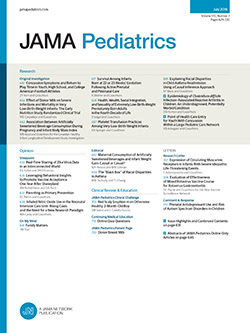Antenatal Corticosteroid in Twin-Pregnant Women at Risk of Late Preterm Delivery: A Randomized Clinical Trial.
IF 18
1区 医学
Q1 PEDIATRICS
引用次数: 0
Abstract
Importance Recent guidelines have recommended corticosteroid injection in women with singleton pregnancies at risk of late preterm delivery. However, the effectiveness of antenatal corticosteroid administration in women with twin pregnancies at risk of late preterm delivery has not been evaluated, and studies on this population are lacking. Objective To evaluate whether antenatal betamethasone administration reduces the risk of neonatal respiratory morbidity in late preterm twin neonates. Design, Setting, and Participants In this multicenter randomized trial, twin-pregnant women at 34 weeks 0 days to 36 weeks 5 days of gestation at risk of late preterm delivery were enrolled across 8 university-based clinical centers in Korea. Data were collected between May 2018 and July 2024. Intention-to-treat analysis was performed. Intervention The participants received 2 injections of betamethasone or placebo after randomization (1:1). Main Outcomes and Measures The primary outcome was perinatal death within 72 hours after birth or severe neonatal respiratory morbidity. The exploratory outcomes were mild neonatal respiratory morbidities, other neonatal respiratory morbidities, other neonatal complications, or maternal complications. Results A total of 812 participants were randomized and analyzed, with 410 in the intervention group (median [IQR] age, 35 [33-37] years) and 402 in the placebo group (median [IQR] age, 35 [32-38] years). Among 1620 neonates (818 in the intervention group and 802 in the placebo group), there were no perinatal deaths in either group, and severe neonatal respiratory morbidity occurred in 99 neonates (6.1%), with lower risk in the betamethasone group than in the placebo group (39 [4.8%] vs 60 [7.5%]; relative risk [RR], 0.64 [95% CI, 0.42-0.98]). For the exploratory outcomes, continuous positive airway pressure use for 2 hours or more (RR, 0.58 [95% CI, 0.35-0.95]) and transient tachypnea of the newborn (RR, 0.47 [95% CI, 0.25-0.89]) were lower in the betamethasone group. The risk of primary outcome and mild respiratory morbidities was reduced only in neonates delivered between 12 hours or more and less than 7 days after the first betamethasone administration. The risk of neonatal hypoglycemia was increased in the betamethasone group (128 [15.6%] vs 94 [11.7%]; RR, 1.33 [95% CI, 1.01-1.75]), but the risk of neonatal sepsis or maternal chorioamnionitis did not differ between the 2 groups. Conclusions and Relevance In this randomized clinical trial, antenatal betamethasone administration in women with twin pregnancies at risk of late preterm delivery significantly reduced the risk of neonatal respiratory morbidity. The outcomes from this study could serve as a valuable reference in clinical management of twin pregnancies at risk of late preterm delivery. Trial Registration ClinicalTrials.gov Identifier: NCT03547791.有晚期早产风险的双胎孕妇产前使用皮质类固醇:一项随机临床试验。
重要性:最近的指南建议对有晚期早产风险的单胎妊娠妇女注射皮质类固醇。然而,对有晚期早产风险的双胎妊娠妇女进行产前皮质类固醇治疗的有效性尚未得到评估,并且缺乏对这一人群的研究。目的评价产前给予倍他米松是否能降低晚期早产儿双胎新生儿呼吸系统疾病的风险。设计、环境和参与者在这项多中心随机试验中,韩国8所大学临床中心招募了妊娠34周0天至36周5天有晚期早产风险的双胎孕妇。数据收集于2018年5月至2024年7月。进行意向治疗分析。干预:随机分组后,参与者接受2次倍他米松或安慰剂注射(1:1)。主要结局和措施主要结局是出生后72小时内围产期死亡或新生儿严重呼吸系统疾病。探索性结果为轻度新生儿呼吸系统疾病、其他新生儿呼吸系统疾病、其他新生儿并发症或产妇并发症。结果共纳入812例受试者,其中干预组410例(中位年龄35[33-37]岁),安慰剂组402例(中位年龄35[32-38]岁)。在1620例新生儿中(干预组818例,安慰剂组802例),两组均无围产期死亡,99例新生儿出现严重呼吸系统疾病(6.1%),倍他米松组风险低于安慰剂组(39例[4.8%]vs 60例[7.5%];相对危险度[RR], 0.64 [95% CI, 0.42-0.98])。对于探索性结果,倍他米松组持续气道正压通气2小时及以上(RR, 0.58 [95% CI, 0.35-0.95])和新生儿短暂性呼吸急促(RR, 0.47 [95% CI, 0.25-0.89])较低。只有在首次使用倍他米松后12小时或更长时间和少于7天的新生儿中,主要结局和轻度呼吸系统疾病的风险才会降低。倍他米松组新生儿低血糖的风险增加(128 [15.6%]vs 94 [11.7%]; RR, 1.33 [95% CI, 1.01-1.75]),但两组之间新生儿败血症或母体绒毛膜羊膜炎的风险无差异。结论及相关性在这项随机临床试验中,双胎晚期早产风险妇女产前给予倍他米松可显著降低新生儿呼吸系统疾病的风险。本研究结果可为双胎妊娠晚期早产风险的临床管理提供有价值的参考。临床试验注册号:NCT03547791。
本文章由计算机程序翻译,如有差异,请以英文原文为准。
求助全文
约1分钟内获得全文
求助全文
来源期刊

JAMA Pediatrics
PEDIATRICS-
CiteScore
31.60
自引率
1.90%
发文量
357
期刊介绍:
JAMA Pediatrics, the oldest continuously published pediatric journal in the US since 1911, is an international peer-reviewed publication and a part of the JAMA Network. Published weekly online and in 12 issues annually, it garners over 8.4 million article views and downloads yearly. All research articles become freely accessible online after 12 months without any author fees, and through the WHO's HINARI program, the online version is accessible to institutions in developing countries.
With a focus on advancing the health of infants, children, and adolescents, JAMA Pediatrics serves as a platform for discussing crucial issues and policies in child and adolescent health care. Leveraging the latest technology, it ensures timely access to information for its readers worldwide.
 求助内容:
求助内容: 应助结果提醒方式:
应助结果提醒方式:


